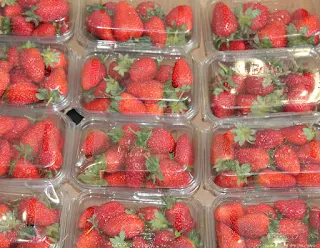Plastic Pollution in Agriculture
Plastic has become an indispensable part of modern agriculture, revolutionizing farming practices and boosting productivity. However, this convenience comes at a significant cost to the environment. In this article, we delve into the rising use of plastic in agriculture, its adverse effects, and explore innovative solutions to mitigate its impact.
The
Rise of Plastic in Agriculture
Plastic
has permeated every aspect of agricultural production in recent decades, from
seedling trays to irrigation pipes. Its widespread adoption can be attributed
to several factors, including its durability, versatility, and
cost-effectiveness. Farmers rely on plastic mulches to suppress weeds, plastic
films for greenhouse cultivation, and plastic containers for packaging and
transportation. In late 2021, the Food and Agriculture Organization of the
United Nations (FAO) released a landmark report assessing the use of plastics
in agriculture. The report calculated that, in 2019, agricultural value chains
used 12.5 million tonnes of plastic products in plant and animal production and
37.3 million tonnes in food packaging.
Impact
of Plastic in Agriculture
Plastic
Mulching: Plastic mulches are widely used to
suppress weeds, conserve soil moisture, and regulate soil temperature. However,
these benefits come at a cost. Over time, plastic mulches degrade into microplastics,
contaminating soil and affecting its fertility.
Plastic
Irrigation Systems: Drip irrigation
systems made of plastic have revolutionized water management in agriculture.
Yet, these systems are prone to leaks and breakages, contributing to plastic
pollution in water bodies and harming aquatic ecosystems.
Plastic
Packaging and Waste: The packaging of
agricultural products in plastic containers and bags has become commonplace.
Once disposed of, these plastics often end up in landfills or oceans, posing a
severe threat to wildlife and marine life.
Environmental
Impact of Plastic in Agriculture
While
plastic has undoubtedly enhanced agricultural efficiency, its improper disposal
poses a grave environmental threat. Plastic waste contaminates soil and water
bodies, leaching harmful chemicals and disrupting ecosystems. Marine life often
mistakes plastic debris for food, leading to ingestion and entanglement,
further exacerbating the problem.
Health
Risks
Chemical
Leaching: Plastic products contain additives
such as phthalates and Bisphenol A (BPA), which can leach into soil and water,
posing potential health hazards to consumers and agricultural workers.
Microplastics
in Food Chain: Microplastics
ingested by soil organisms can bioaccumulated in the food chain, ultimately
reaching humans through the consumption of contaminated crops and livestock
products.
Challenges
in Implementation
Economic
Factors: The transition to sustainable
alternatives may involve upfront costs and investment in new infrastructure.
Economic incentives such as subsidies, grants, and tax credits can help offset
these expenses and incentivize adoption of eco-friendly practices.
Technological
Limitations: Despite
advancements in bioplastics and precision agriculture, certain technological
barriers still hinder widespread adoption. Research and development efforts are
needed to overcome these challenges and accelerate the transition towards a
plastic-free agricultural sector.
Current
Solutions
Biodegradable
Alternatives: Bio-based
plastics derived from renewable sources offer a promising alternative to
conventional plastics. These biodegradable materials break down naturally,
reducing the environmental burden associated with plastic pollution.
Recycling
Initiatives: Recycling
programs aimed at collecting and processing agricultural plastics help minimize
waste and promote a circular economy. By reusing plastic materials, we can
reduce the demand for new plastics and lessen their environmental impact.
Government
Regulations: Governments play
a crucial role in regulating the use and disposal of plastics in agriculture
through policy interventions and incentives. Measures such as plastic bans,
extended producer responsibility schemes, and eco-labeling can encourage
sustainable practices among farmers and agribusinesses.
Innovative
Approaches
Bio-based
Plastics: Researchers are exploring innovative
methods to produce plastics from plant-based materials such as corn starch,
sugarcane, and algae. These bio-based plastics offer comparable performance to
traditional plastics while being biodegradable and environmentally friendly.
Precision
Agriculture Techniques: Precision
agriculture employs advanced technologies such as drones, sensors, and GPS
systems to optimize resource usage and minimize environmental impact. By
precisely targeting inputs such as water, fertilizers, and pesticides, farmers
can reduce their reliance on plastic-intensive practices.
Community
Involvement
Local
Initiatives: Community-led
initiatives such as plastic clean-up drives and recycling programs can mobilize
grassroots support for tackling plastic pollution in agriculture. By engaging residents
and businesses, we can foster a sense of collective responsibility and promote
environmental stewardship at the grassroots level.
Volunteering
Opportunities: Volunteering
with environmental organizations and conservation groups provides individuals
with an opportunity to contribute directly to plastic reduction efforts in
agriculture. Whether it's participating in beach clean-ups or assisting with
recycling initiatives, every act of volunteerism makes a difference in
preserving our planet for future generations.
Future
Prospects
Advancements
in Sustainable Agriculture: As
awareness of the environmental impacts of plastic grows, so too does the
momentum towards sustainable agriculture. With continued innovation and
collaboration, we can develop holistic solutions that prioritize both
productivity and environmental stewardship, ensuring a greener future for
agriculture.
Conclusion
The
increasing use of plastic in agriculture poses a significant threat to the
environment and human health. However, by embracing sustainable alternatives,
promoting awareness, and fostering community involvement, we can mitigate these
impacts and pave the way for a more sustainable agricultural future.
FAQs
What
are the alternatives to plastic in agriculture?
Biodegradable
plastics, bio-based plastics, and sustainable packaging materials are among the
alternatives to traditional plastics in agriculture.
How
can farmers reduce plastic waste on their farms?
Farmers
can adopt practices such as plastic recycling, using biodegradable mulches, and
implementing precision irrigation systems to minimize plastic waste on their
farms.
What
are the most common types of plastic used in agriculture?
Polyethylene
(PE) and polypropylene (PP) are among the most prevalent plastics used in
agriculture due to their durability and versatility.
How
does plastic pollution in agriculture affect human health?
Plastic
pollution can contaminate food and water sources, potentially exposing humans
to harmful chemicals and microplastics with adverse health effects.
Are
there any organic farming methods that can eliminate the need for plastic?
Yes,
several organic farming techniques, such as mulching with organic materials and
employing natural pest control methods, can help minimize reliance on plastic.
Sources: https://www.fao.org/fao-stories/article/en/c/1640871/




